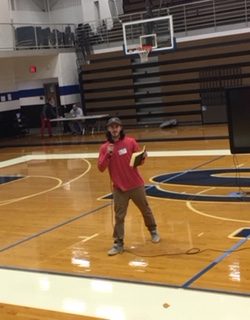Red ribbons; fighting against drug usage

Wearing the ribbon. South often brings in motivational speakers to inspire the students during important times. Red Ribbon Week began in 1988, when DEA Agent Enrique Camarena was murdered during his investigation of drug usage; angered parents and youth began wearing Red Ribbons as a symbol of their commitment to stop the destruction caused by drugs in America. “You can only fulfill goals and dreams with correct choices,” said John.
October 24, 2018
Students file into one of the many the South Forsyth High School gymnasiums. It is October 24th, halfway through the Red Ribbon Week. Students all over campus decide to wear red to support the cause; saying “no” to drugs.
This week, South is celebrating Red Ribbon Week, a week dedicated to making a promise to abstain from drug usage. South Forsyth brought in four motivational speakers. In order to keep identities secret, last names of the speakers were not disclosed. Seniors were spoken to by Tiffany, a woman in recovery while freshmen listened to Tiffany’s sister, Katie. Sophomores heard from Craig, an EMT. John, the man who spoke to juniors, once was stuck in the world of addiction to drugs. He shared his testimony with the students in the hopes of convincing them to say “no” to drugs.
John attended a private Christian school where he ran into rumors of gang violence and drug usage within the walls of a public school. Soon after, he moved and began learning at a public school of which he was corrected in his belief of all the rumors heard at his old school. He became exposed to positive thoughts of weed mixed with peer pressure; he came to the conclusion he would try it one time. He, at the moment, pronounced it harmless. However, in the long run, he discovered participating in drugs had affected him in a negative way. In later years, John injured his knee skateboarding, one of many incidents. He became addicted to hydrocodone and the feeling it gave. After his dad’s death, he became depressed, so he researched how to buy pills on the street. During his search, he found a cheaper option, heroine. His addiction spiraled out of control, he spent thousands of dollars a month and made several trips a week to get more of the drug. He became self-centered, stealing and lying to aid his addiction. After rehab, he started to realize that drugs only end in pain for the ones you love. He had to choose to stop every day and become a better son to his thriving mother, a better brother to his five siblings, and better boyfriend for his girlfriend.
Throughout John’s life, he struggled with relationships within his family and social skills when talking to others; mainly attributed to his addiction. Because he thought the drugs he used were “harmless”, he created a habit of being careless about what he put in his system. When he ended up “obsessed” and “desperate” when he did not have access to the drugs, he quickly became dissatisfied with his life, wishing he could turn it around.
“It doesn’t matter what you’ve done, the next step is the only thing that matters,” said John.
At age 21, John is working hard on his recovery. Every day he fights a battle with himself, trying to keep from falling victim to temptation. Never again will he say “just one time”.




